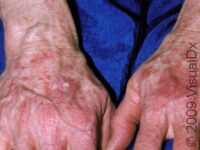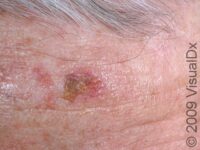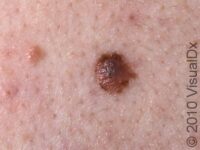
Skin Cancer and Moles
It is well known that excessive sun exposure can promote the development of many skin cancers. The 3 main types of skin cancer are melanoma, basal cell carcinoma (BCC), and squamous cell carcinoma (SCC). Melanoma is the most deadly skin cancer because it spreads (metastasizes) more readily than the other forms of skin cancer. Basal cell carcinoma is the most common form of skin cancer, and it typically does not spread. Squamous cell carcinoma is the second most common form of skin cancer, and while it can spread, it does not do so as commonly as melanoma. The risk of getting basal cell carcinoma or squamous cell carcinoma is determined by a person’s lifetime exposure to sun and the person’s skin color, with pale skin being more prone to skin cancer.
Your awareness of the signs of skin cancer might allow you to find an early lesion on yourself or a loved one, before it is a significant health problem. Pre-cancerous skin changes include red, scaly lesions (especially on the face, ears, and backs of the hands) called actinic keratoses. When on the lip (usually the lower lip), it is called actinic cheilitis. Actinic keratoses are considered to be premalignant lesions as 1 in 100 cases per year will develop into squamous cell carcinoma. Moles that have started to itch or bleed or change in color or shape are also warning signs of possible melanoma.
Moles can be found in sun-exposed or clothing-covered areas. Although it is normal to acquire new moles from childhood through young adulthood, it is unusual to acquire a mole in the adult years. Most moles are normal; atypical moles are seen in any area of the skin, including non-sun-exposed areas. These moles are larger and more irregular in color and shape than normal moles, and they serve as an indicator that the person with these types of moles may be more prone to developing melanoma.
What do types of skin cancer and pre-cancer look like? Click any of the pictures below to learn more about the different types of pre-cancers, skin cancers, and moles. Any new mole, changing mole, or skin lesion of concern should be checked by a dermatologist or your primary physician.




